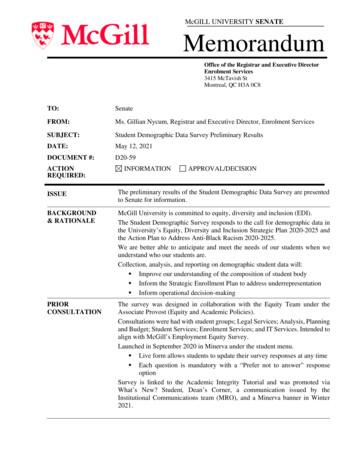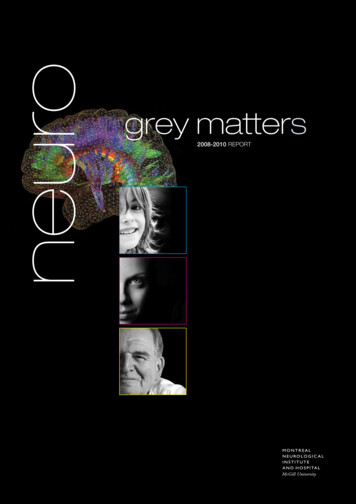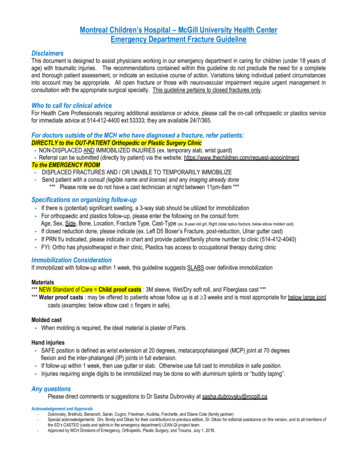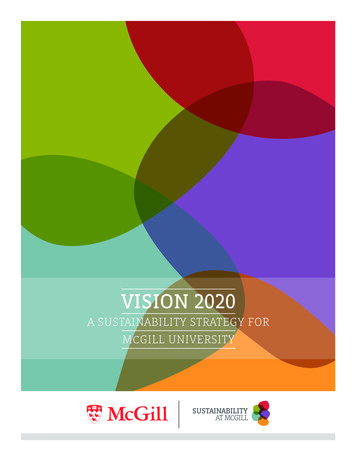
Transcription
McGILL UNIVERSITY SENATEMemorandumOffice of the Registrar and Executive DirectorEnrolment Services3415 McTavish StMontreal, QC H3A 0C8TO:SenateFROM:Ms. Gillian Nycum, Registrar and Executive Director, Enrolment ServicesSUBJECT:Student Demographic Data Survey Preliminary ResultsDATE:May 12, 2021DOCUMENT NISSUEThe preliminary results of the Student Demographic Data Survey are presentedto Senate for information.BACKGROUND& RATIONALEMcGill University is committed to equity, diversity and inclusion (EDI).The Student Demographic Survey responds to the call for demographic data inthe University’s Equity, Diversity and Inclusion Strategic Plan 2020-2025 andthe Action Plan to Address Anti-Black Racism 2020-2025.We are better able to anticipate and meet the needs of our students when weunderstand who our students are.Collection, analysis, and reporting on demographic student data will: Improve our understanding of the composition of student body Inform the Strategic Enrollment Plan to address underrepresentation Inform operational decision-makingPRIORCONSULTATIONThe survey was designed in collaboration with the Equity Team under theAssociate Provost (Equity and Academic Policies).Consultations were had with student groups; Legal Services; Analysis, Planningand Budget; Student Services; Enrolment Services; and IT Services. Intended toalign with McGill’s Employment Equity Survey.Launched in September 2020 in Minerva under the student menu. Live form allows students to update their survey responses at any time Each question is mandatory with a “Prefer not to answer” responseoptionSurvey is linked to the Academic Integrity Tutorial and was promoted viaWhat’s New? Student, Dean’s Corner, a communication issued by theInstitutional Communications team (MRO), and a Minerva banner in Winter2021.
SUSTAINABILITYCONSIDERATIONSN/AIMPACT OFDECISION ANDNEXT STEPSMOTION ORRESOLUTIONFOR APPROVALAPPENDICESN/AThis item is presented for information.Appendix A: Presentation on the preliminary data from the StudentDemographic Survey
D20-59 Appendix AStudent Demographic SurveyReporting of Preliminary Data to SenateMay 12, 2021Gillian NycumRegistrar and Executive Director, Enrolment Services
Student Demographic Survey: Rationale McGill University is committed to equity, diversity and inclusion (EDI). The Student Demographic Survey responds to the call for demographic data in theUniversity’s Equity, Diversity and Inclusion Strategic Plan 2020-2025 and the Action Planto Address Anti-Black Racism 2020-2025. We are better able to anticipate and meet the needs of our students when weunderstand who our students are. Collection, analysis, and reporting on demographic student data will: Improve our understanding of the composition of student body Inform the Strategic Enrollment Plan to address underrepresentation Inform operational decision-makingStudent Demographic Survey Report of Preliminary Data to Senate– May 20212
Student Demographic Survey: Background Survey was designed in collaboration with the Equity Team under the AP Equity andAcademic Policies. Consultations were had with student groups, Legal Services, APB, Student Services, ES,and IT. Intended to align with McGill’s Employment Equity Survey. Launched in September 2020 in Minerva under the student menu. Live form allows students to update their survey responses at any time Each question is mandatory with a “Prefer not to answer” response optionSurvey is linked to the Academic Integrity Tutorial and was promoted via What’s New?Student, Dean’s Corner, an MRO, and a Minerva banner in Winter 2021.Student Demographic Survey Report of Preliminary Data to Senate– May 20213
Student Demographic Survey: Fall 2020 Snapshot of Preliminary Data Data collection is ongoing and preliminary data should be interpreted with caution. New students and undergraduate students are overrepresented Data are not representative by FacultySurvey population excludes students in the following: School of Medicine (MDCM Program, Postgraduate Medical Residency) Ingram School of Nursing School of Physical and Occupational Therapy School of Communication Sciences and Disorders School of Continuing Studies’ Lifelong Learning Quebec Inter-University Transfer Statistics are based on students who received and responded to the survey only. Statistics exclude respondents who opted out (i.e., ‘Prefer not to answer)Student Demographic Survey Report of Preliminary Data to Senate– May 20214
Participation by Level of Study (Fall 2020)Grand ,39135,6051,7849,35714628Total number of students surveyedStudent Demographic Survey Report of Preliminary Data to Senate– May %500000.0%0.0%Number of students who responded (% Level of Study response rate)5
Participation by Faculty (Fall 2020)Grand TotalFaculty of Agric Environ Sci5371,889Faculty of ArtsInterfaculty, B.A. & Sc.School of Continuing StudiesFaculty of DentistryFaculty of Education2,541Faculty of Law875Faculty of ch School of 36,171Total number of students surveyedStudent Demographic Survey Report of Preliminary Data to Senate– May aculty StudiesDesautels Faculty Management3,011252687(26.4%)(28.4%)9,660Faculty of EngineeringFaculty of Medicine & Hlth .0%500000.0%0.0%Number of students who responded (% Faculty response rate)6
Preliminary Data: Gender & Gender Identity When students self-identify their gender, gender representation breaks down as follows: Woman (59.2%) Man (39.0%) Non-binary (1.0%) Two-Spirit ( 1%) Another gender identity ( 1%) Do not know/Questioning ( 1%)Most students identify with their gender assigned at birth (Cisgender, 92.7%), howeversome do not (Transgender, 1%; Two-Spirit, 1%; Another gender identity, 2.9%) andothers are unsure (Do not know/Questioning, 3.4%).Student Demographic Survey Report of Preliminary Data to Senate– May 20217
Preliminary Data: Sexual Orientation When asked their sexual orientation, representation amongst students is as follows: Straight (78.1%) Bisexual (9.7%) Gay (2.6%) Lesbian (1.3%) Queer (1.7%) Pansexual (1.6%) Two-Spirt ( 1%) Asexual ( 1%) Another sexual orientation ( 1%) Do not know/Questioning (3.7%)Student Demographic Survey Report of Preliminary Data to Senate– May 20218
Preliminary Data: Disability “Persons with disabilities” refers to people who experience long-term, persistent orrecurring physical, mental, sensory, psychiatric, or learning disabilities, including thosewith chronic health conditions, which may result in a person experiencing disadvantageor encountering barriers to full participation in university life. 8.3% of McGill students identify as a person with a disability. The most prevalent types of disabilities reported by students are: Mental health disorder (56.8%) Attention Deficit Disorder (32.3%) Learning disability (19.2%) Autism (6.0%) Motor impairment (5.0%)Student Demographic Survey Report of Preliminary Data to Senate– May 20219
Preliminary Data: Racial/Ethnic Identity Terminologies used in the Student Demographic Survey are consistent with the Censusto help the University understand its demography in relation to Canada. Comparisons between McGill student demographics and Census data will be available infuture years once internal data are more robust.Racial/ethnic groupsArabBlackChineseFilipinoKoreanJapaneseLatin AmericanSouth AsianSoutheast AsianWest AsianWhiteAnother racial identity1 Percentages are based2 Percentages may sum% students who identify with each group 1, %on students who received and responded to the survey only, and should not be interpreted as representative of the student body at McGill.to more than 100% as respondents can self-identify with more than one racial/ethnic group.Student Demographic Survey Report of Preliminary Data to Senate– May 202110
Preliminary Data: Racial/Ethnic Identity by Domestic/International Status8.2%5.3%4.7%4.5%10.6%ArabBlack (e.g. African, American, Canadian, Caribbean, .3%9.1%1.8%2.4%2.3%3.3%FilipinoJapaneseKoreanLatin AmericanSouth Asian (e.g. East Indian, Pakistani, Sri Lankan)Southeast Asian (e.g. Vietnamese, Cambodian, Laotian, Thai)West Asian (e.g. Afghan, Iranian)White6.7%4.1%Another racial and/or ethnic 80%90%100%InternationalNotes:Percentages are based on students who received and responded to the survey only, and should not be interpreted as representative of the student body at McGill.Percentages may sum to more than 100% as respondents can self-identify with more than one racial/ethnic group.Student Demographic Survey Report of Preliminary Data to Senate– May 202111
Preliminary Data: Indigenous Persons in North America “Indigenous people in North America” are defined as First Nations (status or non-status),Inuit, and Métis in Canada, as well as Native Americans, Native Hawaiians and AlaskanNatives in the USA. 2.0% of students at McGill with Canadian citizenship identify as an Indigenous person, asdo 0.4% of students with US citizenship.Student Demographic Survey Report of Preliminary Data to Senate– May 202112
Preliminary Data: Parent/Guardian Educational Attainment Most students at McGill have highly educated parents/guardians. 77.5% attended university (29.0% Bachelor’s degree, 29.0% Master’s degree, 12.5%PhD, 7.6% professional degree)10.9% attended other post-secondary (8.8% college/CEGEP, 2.1% trade/vocationalschool)6.0% completed only high school, while 1.2% have less than a high school educationHowever, 13.1% of students at McGill identify as First-Generation (i.e., the first in theirimmediate family to attend university). 11.6% of undergraduates 19.5% of graduate studentsStudent Demographic Survey Report of Preliminary Data to Senate– May 202113
Preliminary Data: Financial Support for Tuition and Living Expenses Students at McGill receive financial support for their education through one or more ofthe following sources: Parents or other family (76.1%) Self-help (e.g., prior savings, part-time work) (48.6%) Scholarships, fellowships, or another award (25.1%) Government student financial assistance program (17.6%) McGill Financial Aid (8.0%) Loan from another institution (4.2%)Starting in June 2021, response options will be more inclusive of and applicable tostudents in the School of Continuing Studies and self-funded programs.Student Demographic Survey Report of Preliminary Data to Senate– May 202114
Preliminary Data: Youth in Care Students are asked if they have ever been in the care of a provincial/state authority (e.g.,foster care, group home, residential facility, etc.) for a period of six months or more. 1% of students at McGill report having been in careStudent Demographic Survey Report of Preliminary Data to Senate– May 202115
Preliminary Data: Student Caregivers 5.3% of students have one or more dependents for whom they are a primary caregiver. 3.8% of undergraduates 11.9% of graduate studentsWho are students caring for?Other dependents,12.7%One or more parents,17.9%One or more children,76.2%Student Demographic Survey Report of Preliminary Data to Senate– May 202116
Preliminary Data: Refugee Status A refugee is a person who is forced to flee their home country to settle in another. 0.5% of students at McGill identify as a refugee. Most have obtained permanent residency status in Canada (93.2%), while theremainder have a pending claim (6.8%).Starting in June 2021, this question focus on the refugee identity (i.e., being a refugee,displaced person, asylum seeker, or stateless person) and will no longer ask aboutrefugee claims.Student Demographic Survey Report of Preliminary Data to Senate– May 202117
Preliminary Data: Language ProficiencyFrench Language ProficiencyEnglish Language ProficiencyIntermediate,7.6%Beginner, 0.3%Beginner,27.8%Professional/NativeSpeaker, 29.2%Advanced,29.6%Professional/NativeSpeaker, 62.4%Student Demographic Survey Report of Preliminary Data to Senate– May 2021Intermediate,22.2%Advanced,29.6%18
Next steps Revised version of the survey integrates feedback from the community. Modifications to existing questions, e.g.,: Glossary for the Gender and Gender Identity questionsGender, Gender Identity, and Sexual Orientation questions will allow respondents toselect more than one response Financial Support question will reference income from full-time work Language and scope of Refugee Status questionNew question about Religion/Spirituality identityChanges will take effect in June 2021Student Demographic Survey Report of Preliminary Data to Senate– May 202119
Appendix: Preliminary Survey Data
Table 1. Responses: Among survey respondents who did not opt outNotes:(1) Survey population excludes students inthe following: School of Medicine Ingram School of Nursing School of Physical andOccupational Therapy School of Communication Sciencesand Disorders School of Continuing Studies’Lifelong Learning Quebec Inter-University TransferStudent Demographic Survey: Fall 2020 Preliminary Data1) Gendera) Please indicate which of the following terms best describe Totalyour gender identity.Manb) Please indicate which of the following terms you bestidentify with:(2) Preliminary data are not representativeof the McGill student body as a wholeand should be interpreted with caution.(3) Statistics are based on those whoresponded to the survey and did not optout (i.e., ‘Prefer not to answer’).(4) Statistics are based on Fall 2020enrolment data as at October 15 withavailable Student Demographic Surveydata appended.2) Sexual OrientationPlease indicate which of the following terms best describeyour sexual orientation.(5) Gender and Sexual Orientationquestions are single select; individualsselect the response option that bestdescribes their identity.(6) Questions regarding Indigenous andracialized identity are not mutuallyexclusive; individuals can self-identify atboth, if applicable.(7) Cell sizes 5 are not reported andreplaced with an asterisk (*)Student Demographic Survey Report of Preliminary Data to Senate– May 2021Count (n)9,292Column o-spirit100.1%Another gender identity220.2%Do not know / 7%Transgender700.8%Two-Spirit190.2%Another gender identity2482.9%Do not know / exual650.7%Another sexual orientation440.5%Do not know / Questioning3193.7%21
Table 1. Responses: Among survey respondents who did not opt outNotes:(1) Survey population excludes students inthe following: School of Medicine Ingram School of Nursing School of Physical andOccupational Therapy School of Communication Sciencesand Disorders School of Continuing Studies’Lifelong Learning Quebec Inter-University TransferStudent Demographic Survey: Fall 2020 Preliminary Data3) DisabilityFor the purposes of this question, "persons withdisabilities" refers to people who experience long-term,persistent or recurring physical, mental, sensory,psychiatric, or learning disabilities, including those withchronic health conditions, which may result in a personexperiencing disadvantage or encountering barriers to fullparticipation in university life.According to this definition, do you identify as a personwith a disability?If you answered "yes", which of the following bestdescribes your disability related barriers at McGill. Youmay select all that apply.(2) Preliminary data are not representativeof the McGill student body as a wholeand should be interpreted with caution.(3) Statistics are based on those whoresponded to the survey and did not optout (i.e., ‘Prefer not to answer’).(4) Statistics are based on Fall 2020enrolment data as at October 15 withavailable Student Demographic Surveydata appended.(5) Gender and Sexual Orientationquestions are single select; individualsselect the response option that bestdescribes their identity.(6) Questions regarding Indigenous andracialized identity are not mutuallyexclusive; individuals can self-identify atboth, if applicable.(7) Cell sizes 5 are not reported andreplaced with an asterisk (*)4) Racial and/or EthnicIdentityTotalYesNoTotalHearing impairmentOrganic impairmentMotor impairmentVisual impairmentMultiple impairmentsAttention Deficit DisorderLearning disabilityMental health disorderAutism SpectrumOther, please specifyPlease indicate which of the following terms best describe Totalyour racial and/or ethnic identity. Check as many terms as Arabapply. We have chosen the listed terms because theyBlack (e.g., African, American, Canadian, Caribbean, etc.)reflect terms used in the Canadian census. UsingChineseterminology consistent with the census will help theFilipinoUniversity to understand our student body in relation to KoreanCanadian demographics.Latin AmericanJapaneseSouth Asian (e.g., East Indian, Pakistani, Sri Lankan)Southeast Asian (e.g., Vietnamese, Cambodian, Laotian,Thai)West Asian (e.g., Afghan, Iranian)WhiteAnother racial and/or ethnic identityStudent Demographic Survey Report of Preliminary Data to Senate– May 2021Count (n)8,8347338,101Column .5%4.7%0.9%6.4%2.0%2335,2325322.6%58.4%5.9%22
Table 1. Responses: Among survey respondents who did not opt outNotes:(1) Survey population excludes students inthe following: School of Medicine Ingram School of Nursing School of Physical andOccupational Therapy School of Communication Sciencesand Disorders School of Continuing Studies’Lifelong Learning Quebec Inter-University TransferStudent Demographic Survey: Fall 2020 Preliminary DataCount (n)Column %5) Indigenous Persons ina) Indigenous people in North America are defined as TotalCanada and the United States First Nations (status or non-status), Inuit, and Métis in YesCanada, as well as Native Americans, Native Hawaiiansand Alaskan Natives in the USA. Do you identify as an NoIndigenous person in North America?Totalb) If yes, please check those that apply to you:9,092100.0%1341.5%8,95898.5%128100.0%First Nations in Canada who are status, treaty, orregisteredFirst Nations in Canada who are non-status, nontreaty, and %(2) Preliminary data are not representativeof the McGill student body as a wholeand should be interpreted with caution.(3) Statistics are based on those whoresponded to the survey and did not optout (i.e., ‘Prefer not to answer’).(4) Statistics are based on Fall 2020enrolment data as at October 15 withavailable Student Demographic Surveydata appended.9Native Americans, Native Hawaiians, and AlaskanNatives from the USA, including enrolled/registered,as well as non-enrolled/non-registeredTotal9,0846) Educational Attainment of Are you the first in your immediate family (includingParents or Guardiansparents or guardians or siblings) to attend university? YesNoDo not knowTotalWhat is the highest educational attainment of yourmost highly educated parent or guardian?Less than high school(5) Gender and Sexual Orientationquestions are single select; individualsselect the response option that bestdescribes their identity.(6) Questions regarding Indigenous andracialized identity are not mutuallyexclusive; individuals can self-identify atboth, if applicable.(7) Cell sizes 5 are not reported andreplaced with an asterisk (*)Student Demographic Survey Report of Preliminary Data to Senate– May 2021High school or equivalentTrade/vocational certificateCollege diploma or certificate/CEGEPBachelor's DegreeProfessional Degree (MD, LLB, etc.)Master's DegreeDoctoral DegreeDo not knowNot %2.1%8.8%29.0%7.6%29.0%12.5%3.4%0.3%23
Table 1. Responses: Among survey respondents who did not opt outNotes:(1) Survey population excludes students inthe following: School of Medicine Ingram School of Nursing School of Physical andOccupational Therapy School of Communication Sciencesand Disorders School of Continuing Studies’Lifelong Learning Quebec Inter-University TransferStudent Demographic Survey: Fall 2020 Preliminary Data7) Financial Support8) Youth in Care9) Student Caregivers(2) Preliminary data are not representativeof the McGill student body as a wholeand should be interpreted with caution.(3) Statistics are based on those whoresponded to the survey and did not optout (i.e., ‘Prefer not to answer’).(4) Statistics are based on Fall 2020enrolment data as at October 15 withavailable Student Demographic Surveydata appended.(5) Gender and Sexual Orientationquestions are single select; individualsselect the response option that bestdescribes their identity.(6) Questions regarding Indigenous andracialized identity are not mutuallyexclusive; individuals can self-identify atboth, if applicable.10) Refugee StatusHow are you covering your tuition and living expenses?Please select all that apply.Are you currently or have you ever been in the care of aprovincial/state authority (e.g., foster care, group home,residential facility, etc.) for a period of six months or more?Dependents can include a minor child or an adult with adisability (parent or other relative) who rely on you for regularday-to-day care. You do not have to be the sole caregiver toconsider yourself a primary caregiver. Do you have one ormore dependents for whom you are a primary caregiver?If yes, please provide more information about yourdependents. Please select all that apply.Are you a refugee?If yes, what is the status of your claim?11) Language proficiencya) What is your level of proficiency in English?b) What is your level of proficiency in French?(7) Cell sizes 5 are not reported andreplaced with an asterisk (*)Student Demographic Survey Report of Preliminary Data to Senate– May 2021Count (n)Column %Total8,784100.0%Financial support from parents or other family membersSelf-Help (e.g. prior savings, summer job, part-time work)Scholarship, fellowships or other awardsGovernment Student Financial Assistance Program (e.g.AFE, OSAP, US Direct Loans)Loan from another institution (e.g. banking line of credit)McGill Financial ,879100.0%Yes, I have one or more dependents.4745.3%No, I don't have any dependents.8,40594.7%Total474100.0%One or more dependent children36176.2%One or more dependent parent8517.9%One or more other dependents6012.7%TotalYesNoTotalRefugee claim pendingPermanent residency status nal / Native al / Native 0%0.3%7.6%29.6%62.4%100.0%27.8%22.2%20.8%29.2%24
The Student Demographic Survey responds to the call for demographic data in . Fall 2020 Snapshot of Preliminary Data . Student Demographic Survey Report of Preliminary Data to Senate - May 2021. 5. Participation by Level of Study (Fall 2020) . Loan from another institution (4.2%) .











